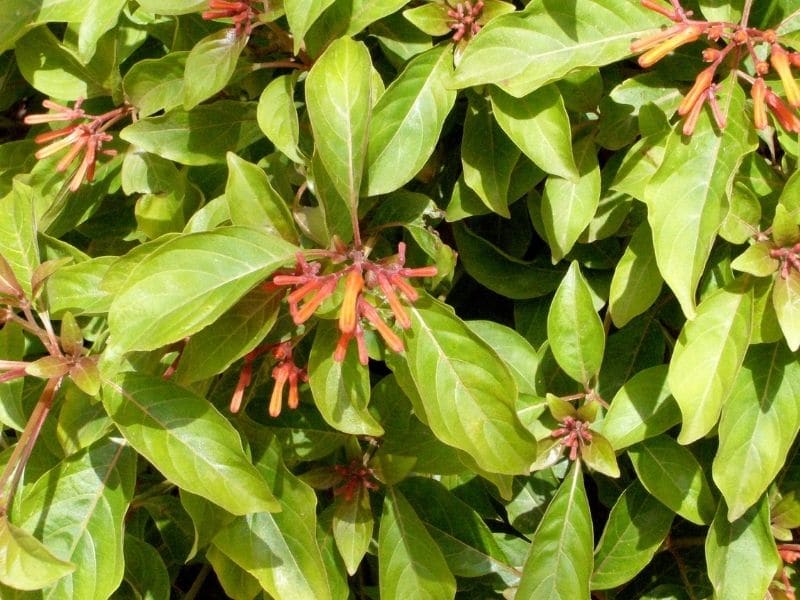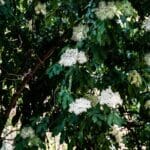Firebush is a brilliant evergreen shrub for USDA zones 9 to 11 that pollinators just can’t get enough of. These low-maintenance plants are fast-growing and make great screens and backgrounds.
Read on to learn more about how to grow and care for the firebush.
What Is A Firebush?
The firebush, Hamelia patens is also known as the Mexican firebush, scarlet bush, hummingbird bush, firecracker bush, or redhead. This stand alone shrub of the Rubiaceae family is a native plant in south Florida, central and south America, and to Argentina.
In the warm, subtropical areas they prefer, these somewhat woody, rounded shrubs will remain evergreen, although they are fast-growing and can be grown as an annual in cooler areas. In the south, these rounded shrubs can grow to over 12 feet (3.6 m) tall with a spread of 6 to 8 feet (1.8 to 2.4 m). They will reach a maximum of less than half that size in areas colder than zone 8 or 9.
You may find a few different varieties of this plant available from nurseries. The variety H. p var. patens is native to Florida. A non-native variety, H. p. var. glabra is also found in the nursery trade and has lighter colored flowers and smooth leaves without hairs.
H. p. var. glabra is often sold as a ‘dwarf’ or ‘compacta’ firebush. While these plants are shorter than the native variety and can be kept relatively small, they can reach over 8 feet (2.4 m) if left unpruned.
The simple leaves of the firebush are between 2 and 8 inches (5 to 20 cm) long. They are interesting leaves that occur in whorls of 3 or 4 (up to 7) and are often covered in fine red hairs when young (1). Mature foliage is attractively marked with red or purple speckling.

Firebush Flowers
The firebush produces tubular orange to red flowers almost throughout the year. When grown as an annual, these plants will blossom from about midsummer until flowering is put on hold by the first frost.
The orange red tubular flowers are five-lobed and grow from ½ inch to 1 inch (13 to 25 mm) long and about ⅛ inch (3 mm) across. Since the firebush blooms for so much of the year, these plants produce a practically continuous crop of small dark red to black fruits that are edible.
How To Grow Firebush Plants
Propagation
Propagation of the Firebush plant (Hamelia patens) can be achieved through several methods. One common approach is by collecting seeds from ripe fruit and sowing them in a well-draining potting mix. Ensure the firebush seeds are fully mature and clean before planting.
Another method is by taking stem cuttings from healthy, mature plants, typically in the late spring or early summer. Remove a section of stem with several leaf nodes and dip the cut end in rooting hormone to encourage root development. Plant the cutting in a moist rooting medium and provide warmth and humidity to facilitate growth.
With proper firebush plant care, both methods can yield new plants.
Sunlight
It is necessary for firebush plants to get at least six hours of direct sunshine on a daily basis in order to achieve maximum development and flowering. Firebush plants thrive in full sun, but they also tolerate partial shade.
Place them in a sunny spot, such a container or garden bed facing south or west, where they will receive plenty of sunshine.
Water
Maintain consistently moist soil for your plants, particularly during the growing season.
Water deeply and thoroughly whenever the top inch of soil feels dry to the touch, but avoid overwatering, which can lead to root rot. Provide supplemental irrigation during periods of drought or hot weather.
Soil
Firebush is also a wonderful plant since, once it has established itself, it is heat and drought tolerant and can thrive in a variety of soils.
Plant Firebush in well drained soil with a slightly acidic to neutral pH. A mix of loamy or sandy soil enriched with organic matter, such as compost or organic peat moss, promotes healthy root development and moisture retention.
Fertilizer
Feed Firebush plants with a balanced, slow-release fertilizer formulated for flowering shrubs, applied according to the manufacturer’s instructions during the growing season. Avoid over-fertilizing, as excessive nitrogen can result in lush foliage at the expense of flowering.
Humidity
Warmth is essential for these plants, and they thrive in southern climates rather than in northern climates or in gardens that are shaded.
The firebush grow best at moderate to high humidity levels. Mist the foliage regularly or place a humidity tray filled with water and pebbles near the plant to increase humidity levels, particularly in dry indoor environments.
Pruning
Prune your semi woody shrub regularly to maintain shape, remove dead or diseased branches, and encourage bushier growth and flowering. Pruning can be done in early spring before new growth emerges or throughout the growing season as needed.
Diseases and Pests
Keep an eye out for common pests such as aphids, mealy bugs, and spider mites, which can infest these native plants and cause damage if left untreated.
Additionally, watch for signs of fungal diseases such as powdery mildew or leaf spot, which can occur in humid conditions or with overwatering. Treat pest infestations promptly with insecticidal soap or neem oil, and provide proper airflow and drainage to prevent fungal diseases.
Uses
Horticultural Uses
Firebush makes a great foundation plant, and can be used as a background to mixed borders. In order to improve the aesthetic value of a landscape, it can be utilized as a specimen plant, a hedge, or as a component of mixed plantings.
One of the great benefits of these plants is the number of pollinators they attract, which makes this a great option for wildlife and pollinator gardens.
Human Uses
These plants are known to have medicinal uses for treating many conditions such as pain, fever, insect bites, and burns. (2) The berries of this plant are edible raw but will taste better when made into jams and jellies.
Wildlife Uses
Hummingbirds, butterflies, and moths are all attracted to the nectar-rich flowers of the firebush shrub. Fruit-eating birds like mockingbirds relish the tasty small fruits. These plants are generally deer resistant.
FAQs
Where is the best place to plant a firebush?
The best place to plant a firebush is in a location that receives full to partial sunlight and has well-draining soil. It can thrive in various soil types, including sandy or loamy soil, and is often used in landscapes, gardens, or as a container plant on patios or decks.
What is the best fertilizer for firebush?
A balanced, slow-release fertilizer with equal parts nitrogen, phosphorus, and potassium is ideal for firebush. Look for a fertilizer specifically formulated for flowering shrubs or follow the recommendations on the product label.
Can you take a cutting from a firebush?
Yes, you can take cuttings from a firebush to propagate new plants. Select healthy, non-flowering stems, and take cuttings that are 4-6 inches long. Remove the lower leaves, dip the cut end in rooting hormone, and plant the cutting in a pot filled with well-draining soil. Keep the soil consistently moist until roots develop.
What can I plant next to a firebush?
Firebush pairs well with other plants that enjoy similar growing conditions, such as tropical or subtropical species. Consider planting it alongside other colorful flowering plants like lantana, pentas, or salvias, as well as foliage plants like ornamental grasses or ferns.
How do you root firebush cuttings?
To root firebush cuttings, place them in a container filled with a well-draining rooting medium such as perlite or a mix of peat moss and perlite. Keep the medium consistently moist and provide bottom heat or a warm, humid environment to encourage root growth. Roots should develop within a few weeks, at which point you can transplant the cuttings into individual pots filled with potting soil.
Conclusion
Firebush is a low-maintenance plant that is simple to cultivate, particularly in tropical or subtropical regions. One of its best qualities is its high-temperature tolerance, which means this plant will thrive where others just can’t handle the heat. If you live in USDA hardiness zones 9 to 11, this is definitely an evergreen shrub worth planting.
Want to learn more about other shrubs you can grow? Check our list here: https://florgeous.com/types-of-shrubs/
References
Reference List:
(1) Welch, W. C. Horticulture Update: Hamelia (Hamelia Patens). Retrieved at https://aggie-horticulture.tamu.edu/newsletters/hortupdate/2009/jun09/Hamelia.html
(2) Dion, B. Hamelia Patens: FGCU Food Forest. Retrieved at https://www.fgcu.edu/cas/communityimpact/foodforest/files/Firebush-ADA.pdf
Close
*image by shahla_bluerich/depositphotos







